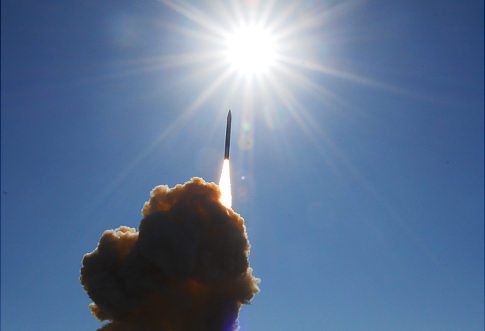Increased interoperability and improved data sharing with international partners are key goals of U.S. Air and Missile Defense, or ADM, especially in the Pacific and U.S. Central Command theaters, said ADM force leaders.
“Today we have Air and Missile Defense forces in nine countries, four combatant command areas of responsibilities,” said Col. Clement Coward, deputy commander of the 32nd Army Air and Missile Defense Command, speaking at an Association of the United States Army “Hot Topics” forum on the subject in Arlington, Virginia, Feb. 12.
U.S. Army Patriot missile units have been deployed or forward stationed for 22 of the last 25 years, Coward said.
“On any given day, nearly half of the Army’s Patriot batteries are outside the continental United States,” Coward said. “We’ve also begun forward deploying THAAD [Terminal High Altitude Area Defense] batteries while we continue to grow the THAAD force.”
“However, we are rapidly approaching an inflection point where we face the risk of breaking our AMD force,” Coward said.
At the current tempo of forward deployments, not only is equipment likely to fail more frequently, Coward said “critical modernization efforts” could be delayed, possibly hindering the force from keeping pace with evolving threats.
Since uncertainty in the global security environment is unlikely to reduce the demand for AMD forces, Coward said security cooperation initiatives with allies can serve several purposes.
“Ongoing theater security cooperation initiatives can help lessen the demand on U.S. Patriot forces, reduce the risk to our forces while setting the conditions to increase our AMD partner capabilities.”
The U.S. Air and Missile Defense partnership with the Gulf Cooperation Council, or GCC, achieves several objectives, including enhancing interoperability, Coward said. The GCC includes the member nations of Bahrain, Kuwait, Oman, Qatar, Saudi Arabia, and the United Arab Emirates.
However, the “largest gap” in improving interoperability is data sharing, Coward said, noting that policies and procedures need to be implemented to facilitate digital data sharing.
“Capacity building can reduce reliance on U.S. Army AMD forces in the region, while interoperability deters potential regional adversaries that may desire to employ theater missile and unmanned aerial system technologies to sow instability in the region,” Coward said.
Despite daily interaction with international partners, “we still have a way to go to achieve reduced reliance on U.S. AMD forces,” Coward said.
Col. Robert Lyons, deputy commander of the 94th Army Air and Missile Defense Command, said building partner capacity and theater security cooperation are key focus areas for the 94th in the Pacific theater.
“We’ve worked hard to gain commonality in the way we fight,” Lyons said.
“From a PACOM [Pacific Command] perspective, AMD forces can provide a very tangible deterrent effect in the theater and they’re very helpful in stabilizing the theater,” Lyons said.
Col. Kelly Spillane, deputy commander of Joint Functional Component Command for Integrated Missile Defense, said “the expanding threat set” coupled with the need to reset and modernize U.S. forces will necessitate greater dependence on allies and partners.










